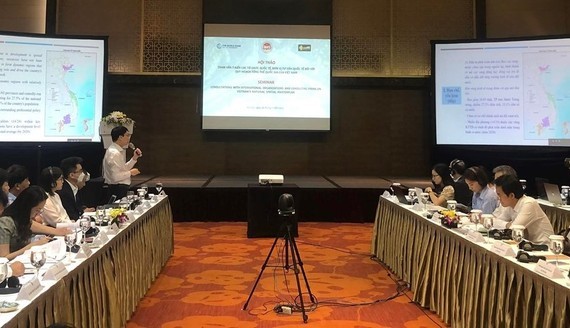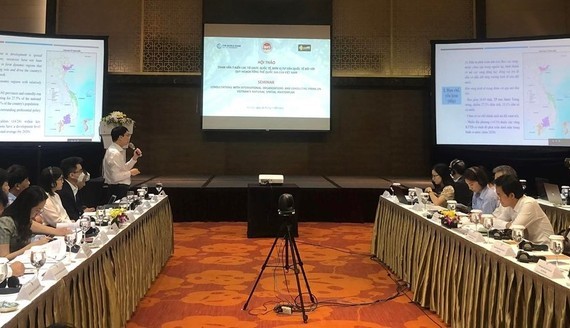
 At the meeting
At the meeting
Today, the Ministry of Planning and Investment coordinated with the World Bank in Vietnam (WB) to organize a seminar to listening to opinions of international organizations and international consulting units for the Master Plan in Hanoi for the period of 2021-2030 with a vision for 2050.
At the workshop, Director of the Institute of Development Strategy under the Ministry of Planning and Investment Tran Hong Quang produced three scenarios of average income in 2030 and 2050.
According to Mr. Tran Hong Quang, the country's population is about 105 million people in 2030, by 2050 it will increase to 115 million people. In option one, with the economy's average GDP growth rate of about 6.34 percent per year in the period 2021-2030, the country's GDP per capita will reach about $7,000 by 2030.
The country’s economy continues to maintain an average GDP growth rate of 6.63 percent a year in the 2031-2050 period GDP per capita in 2050 will reach $25,000 annually. GDP Per Capita is a measurement of the approximate value of a country’s gross domestic product (GDP) contributed by each member of its population.
As per option 2, with an average GDP growth rate of 7.05 percent, a year in the 2021-2030 period, GDP per capita will reach US$7,500 by 2030. In the period 2031-2050, if it continues to be maintained maintaining the average GDP growth rate of the economy at 7.3 percent a year, GDP per capita in 2050 will reach US$32,000.
In the 2031-2050 period, if the average annual GDP growth rate of the economy is only 6.7 percent, the GDP per capita of the country in 2050 will reach US$27,000.
According to the draft national master plan for the period 2021-2030, with a vision for 2050, in the period from now to 2030, the country will develop the North-South economic corridors associated with the North-South expressway and the North-South expressway, the National Highway 1A, and the East-West economic corridor.
At the same time, dynamic zones such as the dynamic triangle Hanoi - Hai Phong - Quang Ninh; the coastal area of Da Nang - Quang Ngai, the dynamic quadrilateral of Ho Chi Minh City - Binh Duong - Dong Nai - Ba Ria - Vung Tau, the triangle of Can Tho - An Giang - Kien Giang will be formed.
The national master plan developed by the Ministry of Planning and Investment also provided comments on four options for zoning and regional linkage. The first option will keep the current division of the country into six socio-economic regions, the remaining three options are to divide the country into seven socio-economic zones in the direction of separating the northern midlands and mountains now into two regions including the northeast and the northwest. The other two options separate the south central region into two central highlands and south central regions.
Commenting on the draft National Master Plan of Vietnam, Dr. Danny Leipziger of the WB said that the planning has shown more attention to the environment, climate change, and economic corridors. The mid-term planning adjustment was also mentioned. In some economic regions, with large-scale projects that need to be carefully selected, the quality of existing investment should be re-evaluated before considering new investment projects.
Dr. Danny Leipziger added that Vietnam should consider the master plan as a living document, which needs to be continuously updated and adjusted every year.
























